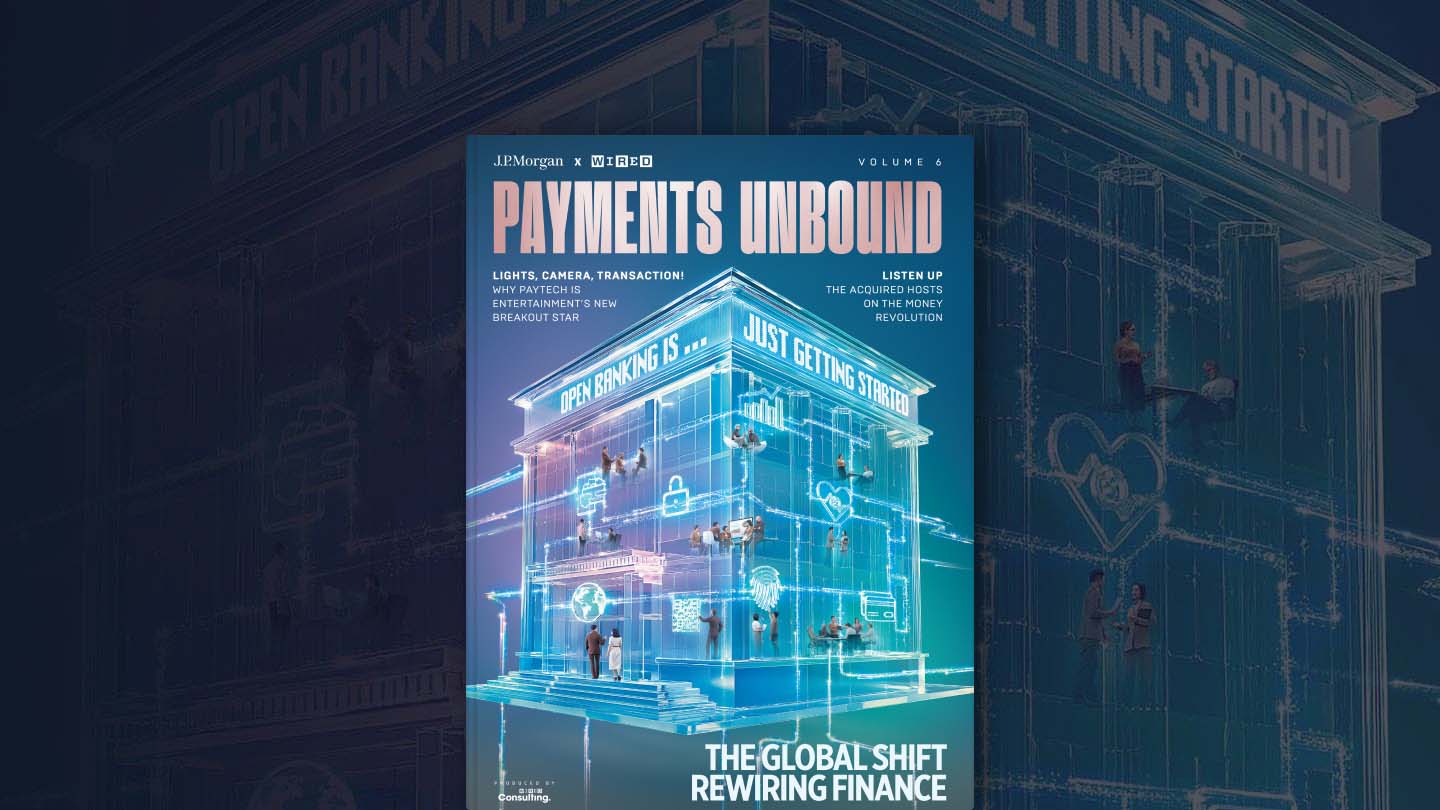Five payment trends
for growth based on
current conditions
Protecting the core
Businesses must optimize core treasury management functions. They cannot afford to leave any money on the table amid economic uncertainty and rising interest rates.
Businesses are entering the third year of navigating a turbulent economic environment, impacting clients’ liquidity and available working capital. Banking mergers and acquisitions (M&A) deals decreased 37% in the first nine months of 2022 compared with 20211, and the drop in fintech valuations drew parallels to the dot com crash from 2000. Rising inflation and interest rates coupled with dampened gross domestic product (GDP) growth forecasts created economic headwinds2. Given all of these complexities, organizations must focus on what they spend, where they spend, and on optimizing their working capital in order to get more for their money.
Supply chains are a key example of where businesses have already and will continue to focus.
In 2022, chip shortages and the Russia-Ukraine conflict amplified preexisting supply-chain issues. Businesses are responding by adopting supply-chain diversification practices such as localizing supply chains, nearshoring and creating buffer stocks of essential components.
With high interest rates and inflation, treasurers must optimize their fundamental working capital operations, understanding it’s no longer an option to leave money on the table. For instance, they should consider freeing trapped liquidity to sit in high-interest bearing accounts. As the cost of external financing increases, Treasurer’s will need to review how they can leverage their idle cash to offer internal financing to high-priority lines of business.
Treasury as an influencer
The treasurer’s role continues to expand as their payments expertise and access to data increases their impact to the business.
Treasurers have a unique skillset and knowledge base, which is now critical to the successful identification and execution of an organization’s growth and evolution. They support an organization’s financial back-end, so they need a seat at the table to advocate for the necessary requirements that bring an innovation to life, driving incremental revenue for their firm.
Treasurers must now rely more on technology in support of their mandates to increase efficiencies within their teams and elevate what capabilities they can offer. Through technology, firms can offer payments-related and growth-focused innovations3 such as:
Cashflow forecasting
to accommodate reconciliation, credit control and other functions impacted by a more continuous inflow and outflow of funds.
Cross-border FX payments
to alleviate liquidity needs introduced by globally-scalable businesses, including the need to both access localized currencies and aggregate them into a centralized liquidity management pool.
Wallet solutions
to streamline and scale payouts with virtual sub-ledgers equipped with flexible payout options and real-time reconciliation.
Innovation through ecosystems
Organizations must prepare for massive opportunities to attract new business through creating ecosystems and expanding them across industries. Businesses will be most effective if they use financial services to elevate their ecosystems.
Businesses are transforming the channels through which their customers interact. They’re creating end-to-end customer journeys that create a more customer-centric experience, which has evolved from platforms and other channels into fully-integrated ecosystems. Research indicates that ecosystems could create a $70 trillion network
economy across at least a dozen sectors by 20303; leading businesses will be the ones who identify how to plug into this high-growth, high-profitability model. Businesses can use payments to support their ecosystems in various ways, especially through embedded finance — a space forecasted to generate $11 billion in revenue by 20264.
Across industries, opportunities abound for corporates, merchants and financial services organizations to elevate ecosystems:
ESG: From promise to impact
Organizations must make good on their commitments to ESG. They can do this with payments through integrating sustainability within supply chains, capital allocation and payments strategy.
Businesses must transition from ESG ideology to practice, producing true, quantifiable and material impacts within their organization. One opportunity is to focus on the ‘S’ of ESG, or social causes such as diversity, equity and inclusion. Research shows that executive teams in the top quartile for ethnic and cultural diversity outperform on profitability by 36% compared to competitors in the bottom quartile5. In light of these types of findings, businesses are hiring executives to foster organizational inclusion, across both specific demographics (e.g., gender and race) and unique backgrounds. And to keep themselves accountable, these executive have an active contributor role in driving positive outcomes against certain profitability metrics.
Businesses can support an inclusive workforce through Earned Wage Access (EWA), or the ability for employees (i.e., contract workers including gig workers) to immediately receive payment on demand. Research indicates that 91% of these employees want more frequent payouts, but only 7% of global employers have the payment and liquidity infrastructure to make daily payments. In response, more companies across industries are adopting real-time payments to accommodate EWA. Other payment products such as prepaid cards are also emerging to support needs within the space.
Sustainability within supply chains is so new that businesses may need time to make significant strides, but it’s still a space worth closely monitoring. Research indicates that only 10% of global demand is met with these innovations6, and the space is forecasted to grow in revenue by 15%-20% annually until 20257. Businesses can take a first step by identifying material ESG risks in their supply chain and then incentivize key suppliers to reform and report sourcing practices by offering more competitive financing rates. Suppliers can also implement cutting-edge practices, such as offering financial incentives and discounts to businesses who purchase supplies from diverse small businesses.
of contract workers, like gig employees, want more frequent payouts
of demand for sustainable financial products is unmet6
potential annual growth for sustainable financial products7
Certain uncertainty
The current economic environment creates uncertainty that can spur opportunities for innovation. Businesses can use analytics and insights to identify the biggest improvements and opportunities.
As businesses enter the third consecutive year of uncertainty, it can prove difficult to prioritize opportunities. However, it’s critical that organizations view this “uncertainty” as a springboard for opportunity. As businesses hone in on their greatest priorities, data and insights can serve as critical tools to objectively evaluate risks and opportunities; once a business is equipped with the right information, they can move forward with innovating.
Uncertain times offer opportunities for innovation8. During the 2007-2009 global financial crisis, ride sharing, hospitability and content streaming industries all experienced disruptive innovation. For instance, some emerging hospitality companies successfully bet on data that Americans would continue to travel amid a downturn
by creating platforms where people could supplement their income through offering their spaces as temporary rentals9. These types of data-driven insights are key for companies across industries to grow amid a difficult economic environment.
The data and insights provided by payments can assist businesses in making similarly thoughtful and growth-oriented decisions by gleaning customer insights such as consumer segmentation, preferences, and spend patterns. Additionally, Treasurers can use merchant acquiring performance metrics to identify and implement improvements with authorization rates, dispute wins, and ultimately cash flow accuracy – all of which will help guide organizations through the extended period of uncertainty.
References
2 Federal Reserve issues FOMC statement. Board of Governors of the Federal Reserve System. (2022, December 14). Retrieved February 6, 2023, from https://www.federalreserve.gov/newsevents/pressreleases/monetary20221214a.htm
3 Joshi, N. H., Khan, H., & Rab, I. (2021, July 27). A design-led approach to embracing an ecosystem strategy. McKinsey & Company. Retrieved February 6, 2023, from https://www.mckinsey.com/capabilities/mckinsey-design/our-insights/a-design-led-approach-to-embracing-an-ecosystem-strategy
4 Harris, M., Davis, A., Adams, B., & Tijssen, J. (2023, January 6). Embedded finance: What it takes to prosper in the new value chain. Bain. Retrieved February 6, 2023, from https://www.bain.com/insights/embedded-finance/#:~:text=Embedded%20banking %20and%20cards%20will,billion%20within%20banking%20and%20cards.
5 Diversity wins: How inclusion matters. McKinsey & Company. (2020, May 19). Retrieved February 6, 2023, from https://www.mckinsey.com/featured-insights/diversity-and-inclusion/diversity-wins-how-inclusion-matters
6 The 2022 McKinsey global payments report: Financial services. McKinsey & Company. (2022). Retrieved February 6, 2023, from https://www.mckinsey.com/industries/financial-services/our-insights/the-2022-mckinsey-global-payments-report
7 The 2022 McKinsey global payments report: Financial services. McKinsey & Company. (2022). Retrieved February 6, 2023, from https://www.mckinsey.com/industries/financial-services/our-insights/the-2022-mckinsey-global-payments-report
8 3 ways to innovate in a downturn. Harvard Business Review. (2022, July 28). Retrieved February 6, 2023, from https://hbr.org/2022/07/3-ways-to-innovate-in-a-downturn
9 The state of the American traveler in October 2022-valuing travel in a recession + dealing with natural disasters. Destination Analysts. (2022, October 3). Retrieved February 6, 2023, from https://www.destinationanalysts.com/blog-the-state-of-the-american-traveler-in-october-2022/







